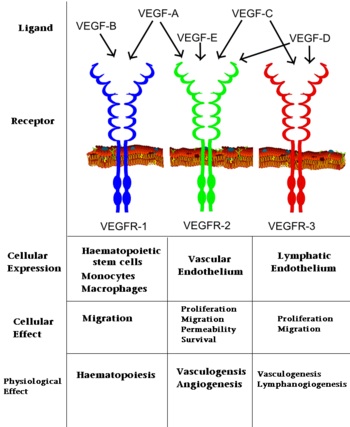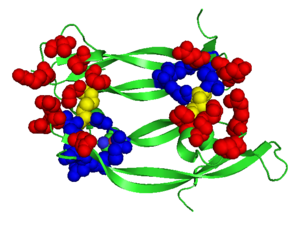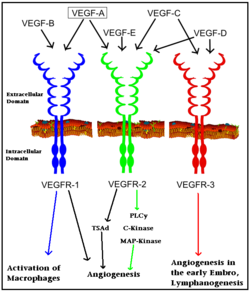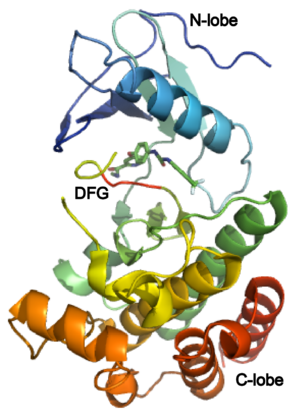Vascular Endothelial Growth Factors (VEGFs) are a class of proteins that regulate vascular development in embryos and angiogenesis in adult mammals after sustaining an injury or notably in cancerous tumors. A number of structural studies have been conducted on VEGF and its receptors (VEGFRs) to better understand the VEGF-VEGFR interaction and how the signal cascade originating from this interaction leads to a number of biological features. VEGF and its receptors have been closely looked at for their potential use as targets for pharmaceutical medicine with some success. The VEGF family contains VEGF-A which mediates increased vascular permeability, VEGF-B which is a growth factor, VEGF-C is active in angiogenesis, VEGF-E is found in viruses and VEGF-F in snake venom.
For additional information see:
VEGFR
VEGF IN COMPLEX WITH A NEUTRALIZING ANTIBODY

Interaction of VEGFs with VEGFRs.
History and Biological Function
VEGF-A was first described by Senger et al. in 1983 as a tumor secreted “vascular-permeability factor (VPF). [1] In 1989, Henzel and Ferrara reported the isolation of an endothelial cell mitogen they named VEGF which also mediated vascular permeability in vivo. Subsequent sequencing revealed that VPF and VEGF were identical, with the VEGF moniker sticking. [2]. VEGF represents a family of homodimeric glycoprotins which are essential for vasculogenesis (embryonic development of blood vessels), Lymphangiogenesis (lymphatic system development) and angiogenesis (formation of new blood vessels from pre-existing ones). [3] VEGF-A, arguably the most important member of the VEGF family, belongs to a gene family that includes placenta growth factor (PIGF) and VEGF’s B, C, D, E (Viral), and F (found in snake toxin) [4].
VEGF is produced by a range of cells including tumor cells, vascular smooth muscle cells, and macrophages. The VEGF-A gene contains a hypoxia responsive element, and hypoxia induces rapid production of VEGF-mRNA[5].The biological function of VEGFs is predicated upon binding to three receptor tyrosine kinases, VEGFR-1-3, that are typically localized on the surface of endothelial cells, bone marrow derived hematopoetic precursor cells, and some malignant cells. [6] VEGF identity determines which of the VEGFRs it binds with high affinity (See Image at the left). VEGF binding of a VEGFR begins a cascade reaction which ultimately leads to angiogenesis, vasculogenesis or haematopoiesis. The biological importance of VEGFs, especially VEGF-A, is highlighted by the fact that VEGF-A -/- knockout mice exhibit severe defects in vascular development and die at E9.5-10.5 [7]. Additionally, loss of just a single VEGF-A allele leads to vascular defects and death by E11-12 [8].
Structure of VEGF-A & its Biology
is a homodimer composed of two 23 kDa subunits. VEGF-A exists in a number of different isoforms following alternative splicing of its precursor mRNA [9]. In humans, 6 variants have been found: VEGF-A-121, VEGF-A-145, VEGF-A-165, VEGF-A-183, VEGF-A-189, and VEGF-A-206, with VEGF-A-165 the most abundantly expressed. All VEGF-A isoforms bind to VEGFR-1 and -2.
The amino acids determined to be are D63, L66, and E67. VEGF-A binding by VEGFR-1 leads to cellular proliferation, migration, and increased cellular permeability resulting in vasculogenesis and angiogenesis. Those residues are I43, I46, Q79, I83, K84 and P85.[10] Binding of VEGF-A to VEGFR-2 results in similar Vasculogenesis and angiogenesis, but also lymphangiogenesis in embryos. The remainder of the is formed by D34, S50, E64, and F36. It is upon binding of VEGFR by VEGF that the subsequent signal cascade is initiated leading to angiogenesis, etc.[11]

Structure of VEGF-E. Red Highlights Binding sites, Blue Highlights the Cysteine Knot, Yellow Highlights the intermolecular Dislufide bonds,
2gnn Structure of VEGF-E as a Model
Although VEGF-E is only found in viral sources and thus is of less importance than VEGF-A, analysis of its structure is informative because it is the only member of the VEGF family that binds exclusively to VEGFR-2, the most essential VEGF receptor. Further, VEGF-E shares significant homology to VEGF-A, and thus can serve as an effective model. [12]
consists of a homodimer that is covalently linked by two intermolecular disulfide bonds between .
Each monomer contains a central antiparallel beta sheet, with the canonical found in other VEGFs. [13] The knot consists of an eight residue ring formed by the backbone of residues 57-61 and 102-104 and intramolecular disulfide bridges Cys57-Cys102 and Cys61-Cys104, and a third bridge, Cys26-Cys68, that passes perpendicularly through the ring. Each VEGF-E monomer contains an amino terminal alpha helix and three solvent accessible loop regions, L2, .
are able to form a complex hydrogen bond network as well as extensive hydrophobic contacts with VEGFR making these loops ideal receptor specificity determinants. Residues: P34, S36, T43, P50, R46, D63, E64, and E67 make up the and are critical for binding to VEGFR-2 as determined by alanine mutagenesis.[14] Further, the salt bridge between is believed to be the source of VEGF-E’s VEGFR-2 specificity by preventing binding to VEGFR-1. [15]

Image of a blood vessel with an erythrocyte (E) within its lumen and endothelial cells form its its tunica intima
Medical Implications
VEGF has received significant attention from the pharmaceutical industry in the hopes of correcting impaired vessel function. Such impaired vessel function accompanies many pathologies including atherosclerosis, arthritis, some neurodegenerative diseases such as ALS, and malignant cell growth such as cancerous tumors. [16] In fact, numerous studies highlighted the increased expression of VEGF in cancer cells resulting in tumoral angiogenesis, providing the tumor with the network of blood vessels need to grow and expand. VEGF expression is stimulated by hypoxia, a common characteristic of most newly formed tumors, and genetic mutations such as K-ras and p53, extremely common mutations present in a majority of cancers. [17] Since angiogenesis in typical adults is infrequent while extremely common in tumors, VEGF serves as a selective therapeutic target for cancer. A number of drugs, like Bevacizumab (a monoclonal antibody better known as Avastin) have been developed to interrupt the VEGF-VEGFR connection, with some success. Avastin binds to and inhibits all VEGF-A isoforms and has achieved megablockbuster status by earning over $5 billion in 2009 for Roche. [18]
3D Structures of VEGF
VEGF 3D Structures
Vascular Endothelial Growth Factor Receptors (VEGFRs) are tyrosine kinase receptors responsible for binding with VEGF to initiate signal cascades that stimulate angiogenesis among other effects[19]. VEGFRs convey signals to other signal transduction effectors via autophosphorylation of specific residues in its structure. Because VEGFRs are up-regulated in cancerous tumors which have a high metabolic need for oxygen, VEGFRs are an important target for pharmaceutical drugs treating cancer. VEGFR subtypes are numbered 1,2,3.

Interaction of VEGFs with VEGFRs. Colored arrows indicate major pathway. Black arrows indicate minor pathway.
See also Kinase-linked, enzyme-linked and related receptors.
Biological Function
The VEGFRs are a family of tyrosine kinase receptors on the surface of different cells depending on family identity. VEGFR-1 is expressed on haematopoietic stem cells, monocytes, and vascular endothelial cells. VEGFR-2 is expressed on vascular endothelial cells and lymphatic endothelial cells, while VEGFR-3 is only expressed on lymphatic endothelial cells[20].
In terms of function, VEGFR-1 is required for the recruitment of haematopoietic stem cells as well as the migration of monocytes and macrophages while VEGFR-2 regulates vascular endothelial function and VEGFR-3 regulates lymphatic endothelial cell function.[21] VEGFR-2 has been the focus of the most research as it is the major signal transducer of both physioligcal, and perhaps more importantly, pathological angiogenesis, especially in cancerous tumors. VEGFR-2 is of critical importance to the body as exemplified by Shalaby et al. who demonstrated that VEGFR-2 gene knockout mice die at E8-8.5 due to lack of vasculogenesis.[22] The signal cascade initiated by binding VEGF to VEGFR is dependent upon specific sites of phosphorylation in the VEGFR structure and the interaction between these phosphorylated sites and other signaling molecules.
Structure of VEGFR-2 and Biology
The structure of VEGFR-2 can been seen at the right. VEGF-A binds to the second and third extracellular Ig-like domains of VEGFR-2 with a 10-fold lower affinity than it does to the second Ig-like domain of VEGFR-1, despite the fact that VEGFR-2 is the principal mediator of several physiological effects on endothelial cells including proliferation, migration, and survival.[23] Binding of VEGF to the domains 2 and 3 of a VEGFR-2 monomer increases the probability that an additional VEGFR-2 binds the tethered ligand to form a dimmer. Once the two receptors are cross-linked, interactions between their membrane-proximal domain 7s stabilize the dimmer significantly. This dimerization and stabilization allows for precise positioning of the intracellular kinase domains, resulting in autophosphorylation and subsequent activation of the classical extracellular signal-regulated kinases (ERK) pathway.[24].
The tyrosine kinase domain of VEGFR-2 is separated into two segments with a 70 amino acid long kinase insert region. Upon binding VEGFA and subsequent dimerization, VEGFR-2 is autophosphoryalted at the carboxy terminal tail and kinase insert region. Six tyrosine residues of VEGFR2 are autophosphorylated (see Fig.1[25]). within the activation loop of VEGFR2 leads to increased kinase activity[26].
Medical significance

Sorafenib, anti VEGFR drug targeting the MAP Kinase pathway, marketed by Bayer for Renal and Liver
Cancer.
VEGFRs play a critical role in a number of signal transduction pathways essential for angiogenesis and cell migration. VEGFR is a particularly attractive target because they are expressed almost exclusively in endothelial cells and are highly upregulated in many tumor endothelium types.[27] In fact, work by Plate et al. revealed that VEGFR-2 expression is 5 fold higher in the tumor vasculature than in normal vasculature. This increased VEGFR-2 expression is due to a cancer cells high metabolic demand for oxygen and other nutrients to continue growing, thus requiring a vast vasculature. VEGFR signaling has also been implicated in diabetic reinopathy and the progression of rheumatoid arthritis and atherosclerosis.[28]
Bevacizumab (Avastin) is a recombinant monoclonal antibody marketed by the pharmaceutical company Roche. It earned over $5 billion dollars in 2009 treating a number of cancers. It’s principal mechanism of action is as an anti-VEGF antibody that favors antiangiogenesis in the tumor microenvironment while effecting the rest of the body to a lesser extent. It has been found to decrease tumor vascular permeability subsequently reducing the delivery of oxygen and nutrients to cancer cells when used in combination with chemotherapy.[29] Other drugs target VEGFR such as Sorafenib (Nexavar), Sunitinib (Sutent) and Vandetanib, binding to various parts of the receptor, either preventing interaction with VEGF or with other downstream signaling molecules.
Additional Resources
For additional information, see:





